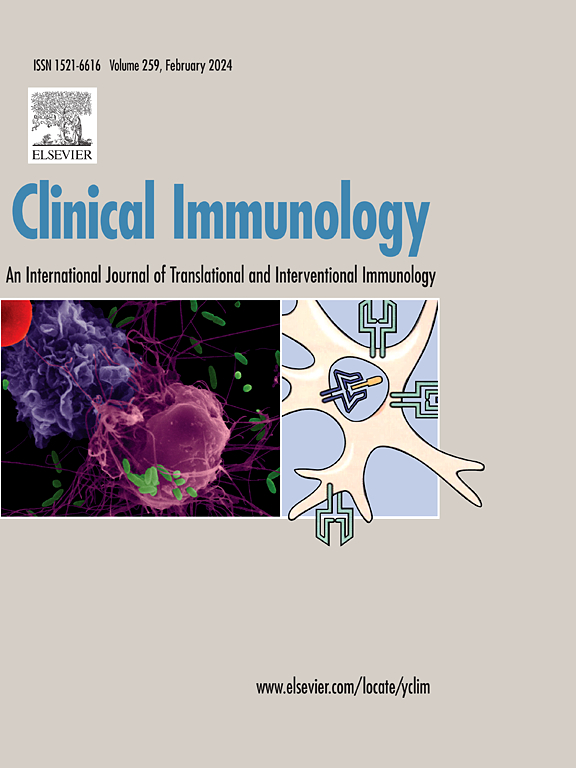产生il -10的DNT细胞的增加与儿童SLE的发病机制有关
IF 3.8
3区 医学
Q2 IMMUNOLOGY
引用次数: 0
摘要
系统性红斑狼疮(SLE)是一种慢性自身免疫性疾病,导致免疫系统过度活跃和器官损伤。在参与SLE的t细胞亚群中,CD4和CD8双阴性αβT (DNT)细胞近年来引起了人们的关注,尽管它们在SLE中的作用尚不清楚。检查微小的复杂性,特别是信号通路的改变是至关重要的,因为它可能揭示潜在的治疗靶点,并导致更有效治疗的发展。我们的研究发现,小儿SLE患者DNT细胞增加,IL-10信号升高。这些产生il -10的DNT细胞与SLE疾病活动指数(SLEDAI)定义的疾病活动呈正相关,并且在狼疮肾炎患者中进一步升高。此外,我们的结果表明,产生il -10的DNT细胞与抗sm自身抗体呈正相关。总的来说,我们的研究表明,在dnt细胞亚群中调节IL-10的产生可能影响免疫调节和自身抗体的产生,从而导致SLE的免疫失调。本文章由计算机程序翻译,如有差异,请以英文原文为准。
An increase in IL-10-producing DNT cells is associated with the pathogenesis of pediatric SLE
Systemic lupus erythematosus (SLE) is a chronic autoimmune disease that causes immune system overactivity and organ damage. Among T-cell subsets involved in SLE, CD4 and CD8 double-negative αβT (DNT) cells have attracted attention in recent years, although their role in SLE remains poorly understood. Examining the minute intricacies, particularly signaling pathway modifications is crucial, as it may unveil potential therapeutic targets and lead to the development of more effective treatments. Our study found increased DNT cells in pediatric SLE patients, with elevated IL-10 signaling. These IL-10-producing DNT cells were positively related to disease activity defined by SLE Disease Activity Index (SLEDAI), and were further elevated in patients with lupus nephritis. Additionally, our results indicated that IL-10-producing DNT cells correlated positively with anti-Sm autoantibodies. Collectively, our study revealed that modulation of IL-10 production within DNT-cell subset could affect both immune regulation and autoantibody production, contributing to the immunological dysregulation in SLE.
求助全文
通过发布文献求助,成功后即可免费获取论文全文。
去求助
来源期刊

Clinical immunology
医学-免疫学
CiteScore
12.30
自引率
1.20%
发文量
212
审稿时长
34 days
期刊介绍:
Clinical Immunology publishes original research delving into the molecular and cellular foundations of immunological diseases. Additionally, the journal includes reviews covering timely subjects in basic immunology, along with case reports and letters to the editor.
 求助内容:
求助内容: 应助结果提醒方式:
应助结果提醒方式:


